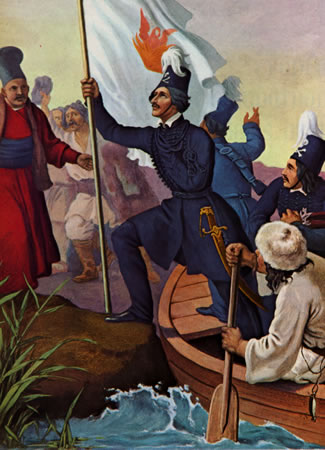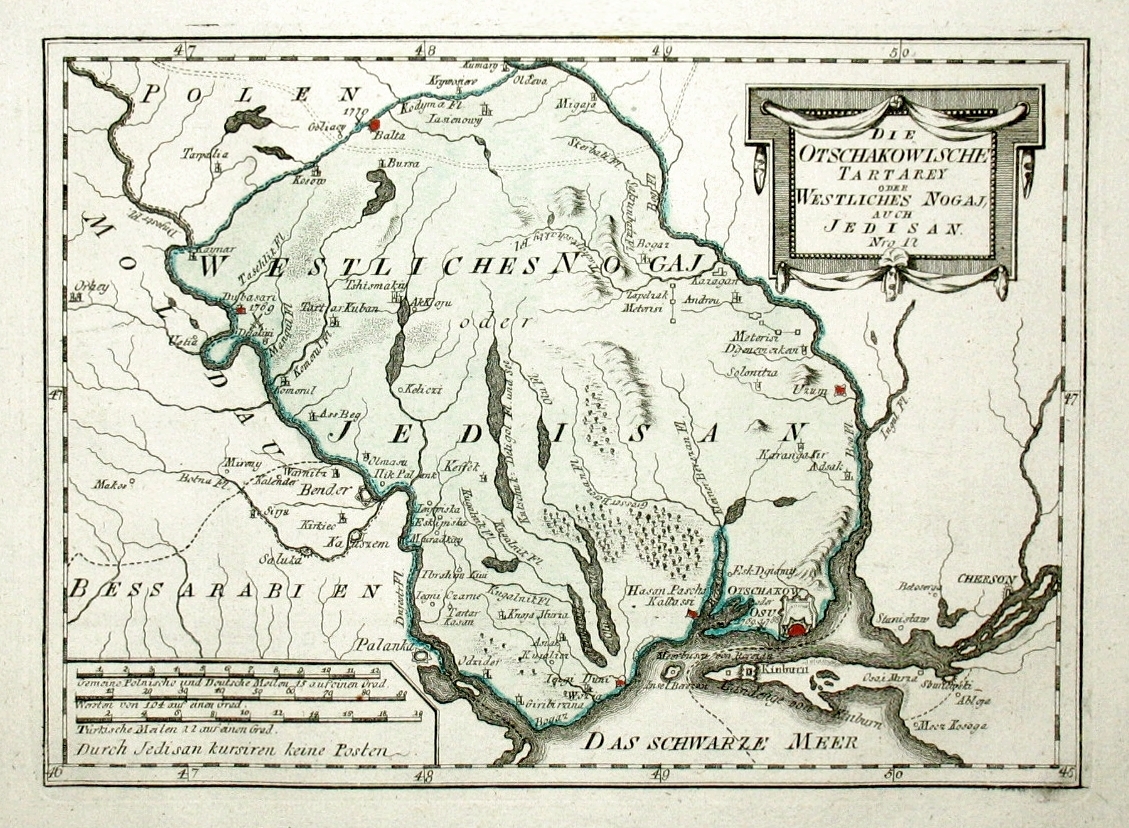|
3rd Guards Fighter Aviation Corps
The 3rd Guards Iasi Order of Suvorov Fighter Aviation Corps () was an aviation corps of the Soviet Air Force formed during World War II. The corps was formed in December 1942 as the 4th Fighter Aviation Corps and received Guards status in July 1944. Postwar, the corps was renumbered as the 72nd Guards Fighter Aviation Corps and transferred to the Soviet Air Defense Forces. It was reorganized as an air defense division in 1960. World War II The corps headquarters was formed in December 1942 in Moscow Oblast as the 4th Fighter Aviation Corps (IAK). It initially included the 265th and 302nd Fighter Aviation Divisions (IAD) and smaller separate units. The 294th IAD joined the corps in accordance with a 13 December directive and the 265th IAD left it on 8 January 1943. The corps was commanded by Colonel Ivan Podgorny (promoted to major general in March 1943 and lieutenant general in September 1944) for the entire war. Until mid-March 1943 the corps remained in the Reserve of the ... [...More Info...] [...Related Items...] OR: [Wikipedia] [Google] [Baidu] |
Soviet Union
The Soviet Union,. officially the Union of Soviet Socialist Republics. (USSR),. was a List of former transcontinental countries#Since 1700, transcontinental country that spanned much of Eurasia from 1922 to 1991. A flagship communist state, it was nominally a Federation, federal union of Republics of the Soviet Union, fifteen national republics; in practice, both Government of the Soviet Union, its government and Economy of the Soviet Union, its economy were highly Soviet-type economic planning, centralized until its final years. It was a one-party state governed by the Communist Party of the Soviet Union, with the city of Moscow serving as its capital as well as that of its largest and most populous republic: the Russian Soviet Federative Socialist Republic, Russian SFSR. Other major cities included Saint Petersburg, Leningrad (Russian SFSR), Kyiv, Kiev (Ukrainian Soviet Socialist Republic, Ukrainian SSR), Minsk (Byelorussian Soviet Socialist Republic, Byelorussian SSR), Tas ... [...More Info...] [...Related Items...] OR: [Wikipedia] [Google] [Baidu] |
Belgorod–Kharkov Offensive Operation
The Belgorod–Kharkov strategic offensive operation, or simply Belgorod–Kharkov offensive operation, was a Soviet strategic summer offensive that aimed to recapture Belgorod and Kharkov, and destroy the German forces of the 4th Panzer Army and Army Detachment Kempf. The operation was codenamed Operation Polkovodets Rumyantsev (russian: Полководец Румянцев), after the 18th-century Field Marshal Peter Rumyantsev and was conducted by the Voronezh and Steppe Fronts (army groups) in the southern sector of the Kursk Bulge. The battle was referred to as the Fourth Battle of Kharkov (german: Vierte Schlacht bei Charkow) by the Germans. The operation began in the early hours of 3 August 1943, with the objective of following up the successful Soviet defensive effort in the Battle of Kursk. The offensive was directed against the German Army Group South's northern flank. By 23 August, the troops of the Voronezh and Steppe Fronts had recaptured Kharkov. It was the last ... [...More Info...] [...Related Items...] OR: [Wikipedia] [Google] [Baidu] |
6th Guards Fighter Aviation Division
The 6th Guards Don-Szeged Red Banner Order of Suvorov Fighter Aviation Division was a fighter aviation division of the Soviet Air Force during World War II and the Cold War. The division was formed in early 1943 from the 268th Fighter Aviation Division, which distinguished itself in the Battle of Stalingrad. After the end of the war, the division was stationed in East Germany from 1951 to the end of the Cold War. World War II The division was formed in June 1942 as the 268th Fighter Aviation Division (IAD) from the maneuver aviation group of the Air Force of the Southwestern Front. The division was initially commanded by Lieutenant Colonel Andrey Ryazanov, who was replaced by Colonel Boris Sidnev in early July. Between June and December, as part of the 8th Air Army (transferred to the Stalingrad Front on 12 July), the 268th IAD was involved in heavy fighting on the Kharkov axis and the Battle of Stalingrad. During this period, it flew 5,278 combat sorties and was credited w ... [...More Info...] [...Related Items...] OR: [Wikipedia] [Google] [Baidu] |
1st Guards Cavalry Mechanized Group
First or 1st is the ordinal form of the number one (#1). First or 1st may also refer to: *World record, specifically the first instance of a particular achievement Arts and media Music * 1$T, American rapper, singer-songwriter, DJ, and record producer Albums * ''1st'' (album), a 1983 album by Streets * ''1st'' (Rasmus EP), a 1995 EP by The Rasmus, frequently identified as a single * ''1ST'', a 2021 album by SixTones * ''First'' (Baroness EP), an EP by Baroness * ''First'' (Ferlyn G EP), an EP by Ferlyn G * ''First'' (David Gates album), an album by David Gates * ''First'' (O'Bryan album), an album by O'Bryan * ''First'' (Raymond Lam album), an album by Raymond Lam * ''First'', an album by Denise Ho Songs * "First" (Cold War Kids song), a song by Cold War Kids * "First" (Lindsay Lohan song), a song by Lindsay Lohan * "First", a song by Everglow from ''Last Melody'' * "First", a song by Lauren Daigle * "First", a song by Niki & Gabi * "First", a song by Jonas Brothe ... [...More Info...] [...Related Items...] OR: [Wikipedia] [Google] [Baidu] |
Debrecen Offensive Operation
The Battle of Debrecen, called by the Red Army the ''Debrecen Offensive Operation'', was a battle taking place 6–29 October 1944 on the Eastern Front in Hungary during World War II. The offensive was conducted by the 2nd Ukrainian Front under Marshal Rodion Malinovsky. It was opposed by General Maximilian Fretter-Pico's German Sixth Army (II formation) and the allied Hungarian VII Army Corps of Army Group South Ukraine The German and Hungarian units were forced to retreat some 160 kilometers, while opposing the 2nd Ukrainian Front which had Debrecen as its strategic objective. Background In the wake of the coup d'état of 23 August 1944, Germany's former ally, Romania declared war on Germany and its ally Hungary. The subsequent drive of Soviet General Fedor Tolbukhin's 3rd Ukrainian Front into Romania destroyed any semblance of an organised defensive line. On 8 September, Bulgaria, another former German ally, declared war on Germany. By this time, Tolbukhin, aided by ... [...More Info...] [...Related Items...] OR: [Wikipedia] [Google] [Baidu] |
Iași
Iași ( , , ; also known by other #Etymology and names, alternative names), also referred to mostly historically as Jassy ( , ), is the second largest city in Romania and the seat of Iași County. Located in the historical region of Western Moldavia, Moldavia, it has traditionally been one of the leading centres of Romanian social, cultural, academic and artistic life. The city was the capital of the Principality of Moldavia from 1564 to 1859, then of the United Principalities from 1859 to 1862, and the capital of Kingdom of Romania, Romania from 1916 to 1918. Known as the Cultural Capital of Romania, Iași is a symbol of Romanian history. Historian Nicolae Iorga stated that "there should be no Romanian who does not know of it". Still referred to as "The Moldavian Capital", Iași is the main economic and business centre of Romania's Moldavian region. In December 2018, Iași was officially declared the Historical Capital of Romania. At the 2011 Romanian census, 2011 census, th ... [...More Info...] [...Related Items...] OR: [Wikipedia] [Google] [Baidu] |
Second Jassy–Kishinev Offensive
The second (symbol: s) is the unit of time in the International System of Units (SI), historically defined as of a day – this factor derived from the division of the day first into 24 hours, then to 60 minutes and finally to 60 seconds each (24 × 60 × 60 = 86400). The current and formal definition in the International System of Units ( SI) is more precise:The second ..is defined by taking the fixed numerical value of the caesium frequency, Δ''ν''Cs, the unperturbed ground-state hyperfine transition frequency of the caesium 133 atom, to be when expressed in the unit Hz, which is equal to s−1. This current definition was adopted in 1967 when it became feasible to define the second based on fundamental properties of nature with caesium clocks. Because the speed of Earth's rotation varies and is slowing ever so slightly, a leap second is added at irregular intervals to civil time to keep clocks in sync with Earth's rotation. Uses Analog clocks and watches often ... [...More Info...] [...Related Items...] OR: [Wikipedia] [Google] [Baidu] |
Prut
The Prut (also spelled in English as Pruth; , uk, Прут) is a long river in Eastern Europe. It is a left tributary of the Danube. In part of its course it forms Romania's border with Moldova and Ukraine. Characteristics The Prut originates on the eastern slope of Mount Hoverla, in the Carpathian Mountains in Ukraine (Ivano-Frankivsk Oblast). At first, the river flows to the north. Near Yaremche it turns to the northeast, and near Kolomyia to the south-east. Having reached the border between Moldova and Romania, it turns even more to the south-east, and then to the south. It eventually joins the Danube near Giurgiulești, east of Galați and west of Reni. Between 1918 and 1939, the river was partly in Poland and partly in Greater Romania (Romanian: ''România Mare''). Prior to World War I, it served as a border between Romania and the Russian Empire. After World War II, the river once again denoted a border, this time between Romania and the Soviet Union. Nowadays, for a l ... [...More Info...] [...Related Items...] OR: [Wikipedia] [Google] [Baidu] |
Dniester
The Dniester, ; rus, Дне́стр, links=1, Dnéstr, ˈdⁿʲestr; ro, Nistru; grc, Τύρᾱς, Tyrās, ; la, Tyrās, la, Danaster, label=none, ) ( ,) is a transboundary river in Eastern Europe. It runs first through Ukraine and then through Moldova (from which it more or less separates the breakaway territory of Transnistria), finally discharging into the Black Sea on Ukrainian territory again. Names The name ''Dniester'' derives from Sarmatian ''dānu nazdya'' "the close river." (The Dnieper, also of Sarmatian origin, derives from the opposite meaning, "the river on the far side".) Alternatively, according to Vasily Abaev ''Dniester'' would be a blend of Scythian ''dānu'' "river" and Thracian ''Ister'', the previous name of the river, literally Dān-Ister (River Ister). The Ancient Greek name of Dniester, ''Tyras'' (Τύρας), is from Scythian ''tūra'', meaning "rapid." The names of the Don and Danube are also from the same Indo-Iranian word '' ... [...More Info...] [...Related Items...] OR: [Wikipedia] [Google] [Baidu] |
Southern Bug
, ''Pivdennyi Buh'' , name_etymology = , image = Sunset S Bug Vinnitsa 2007 G1.jpg , image_size = 270 , image_caption = Southern Bug River in the vicinity of Vinnytsia, Ukraine , map = PietinisBugas.png , map_size = 270px , map_caption = Southern Bug through Ukraine , pushpin_map = , pushpin_map_size = , pushpin_map_caption= , subdivision_type1 = Country , subdivision_name1 = Ukraine , subdivision_type2 = , subdivision_name2 = , subdivision_type3 = Oblast , subdivision_name3 = , subdivision_type4 = , subdivision_name4 = , subdivision_type5 = , subdivision_name5 = , length = , width_min = , width_avg = , width_max = , depth_min = , depth_avg = , depth_max = , discharge1_location= , discharge1_min = , discharge1_avg = 108 m3/s , discharge1_max = , source1 = , source1_location = ... [...More Info...] [...Related Items...] OR: [Wikipedia] [Google] [Baidu] |




